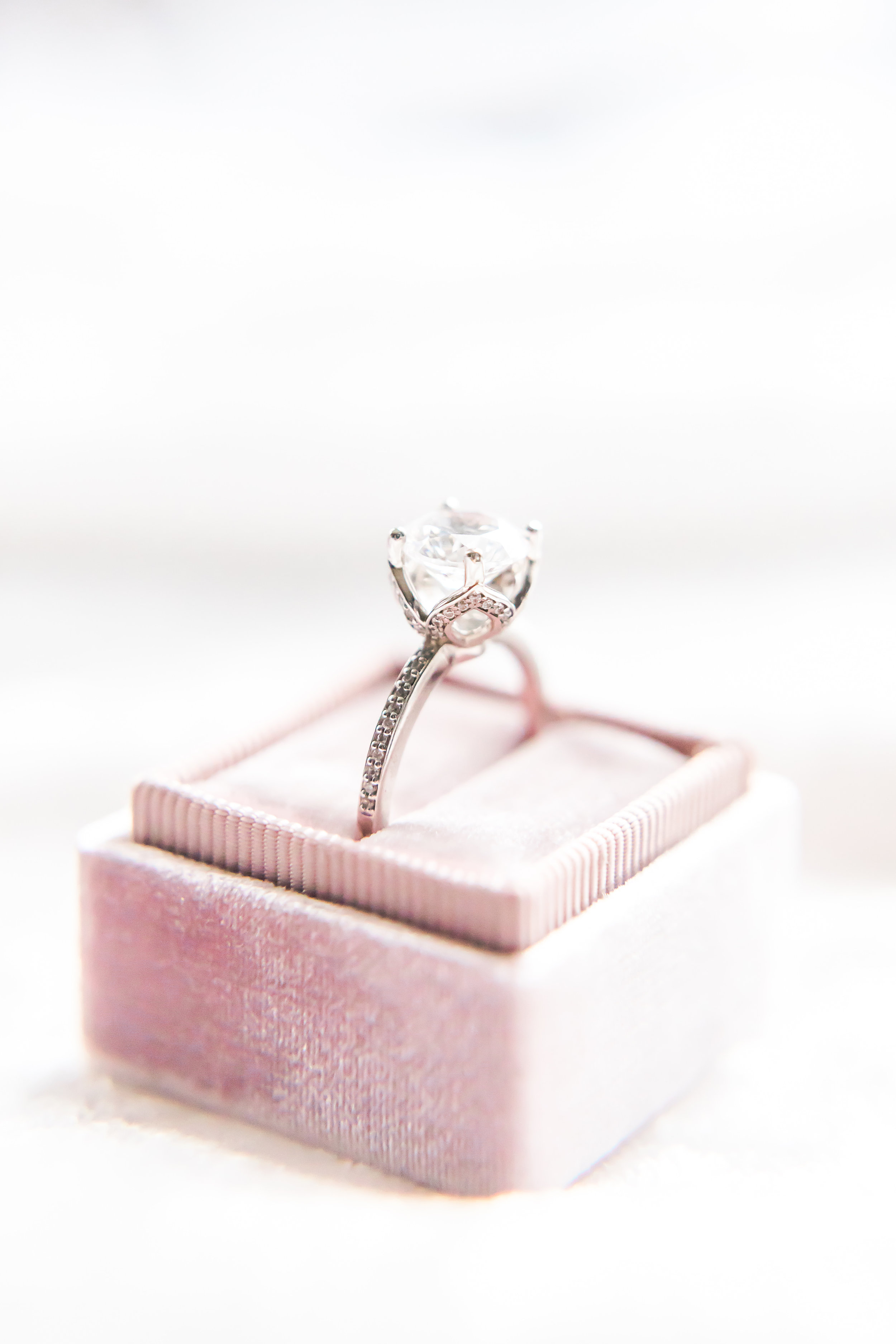Engagement Ring Setting Styles
I loved how The Knot broke down all the ins and outs of each ring setting style and thought it was worth the share since I get questions about setting styles with every client.
6 Engagement Ring Settings to Know About (Plus How to Choose the Right Setting for You)
Your engagement ring setting should get the same attention as that sparkly center stone. Here's your official guide to engagement ring settings.
by The Knot
Image by Gracious Co
Once you've chosen a stone for your engagement ring, you get to choose the perfect setting to complement it. Although the stone can account for up to 90 percent of the cost of the ring, the setting really defines your engagement ring style and showcases the stone's best facets assets. When engagement ring shopping, be open-minded and curious—it's important to ask lots of questions and try on a variety of different ring styles, even ones you’re not in love with (yet). For instance, you may never have considered a halo ring setting, but totally change your mind once you see it on your own finger.
When deciding on an engagement ring setting, think about your budget, lifestyle and design preferences to make sure you and your sparkler are a perfect match. Here are the pros and cons of eight popular engagement ring settings and styles to get you thinking about your dream ring.
Image by Gracious Co
Popular Types of Engagement Ring Settings and Styles
1. Prong Setting
A prong setting is the most common type of engagement ring setting and involves three to six "claws" that hold a stone firmly in a metal "head" or "basket." Prongs can be pointed, rounded, flat or V-shaped, and act as "pockets" for a square stone's corners. When deciding between four and six prongs, note that four prongs will show more of the diamond, while six prongs will keep it more secure, but possibly overwhelm a smaller stone. If you have a heart-, marquise- or pear-shaped stone, its points should be cradled in a V-shaped prong for protection, while flat prongs are recommended for emerald-cut stones.
You’ll Love It Because...
A prong setting permits the most light exposure from all angles and therefore maximizes a diamond's brilliance and "lightens up" richly colored gems.
They use less metal, which often means less time and money is required than other setting styles.
It allows for easy cleaning of the stone.
It holds even the most fragile (or soft) gems securely in place.
You Might Not Like It Because…
It offers less protection to the stone than other setting styles, since most of the girdle (the outer perimeter of the stone) is exposed.
It can get caught in hair or snag clothing more easily.
High-set prong settings can scratch and hurt other people if brushed against, and are hard to fit in gloves. (Lower prong settings are available and more practical for those on the go.)
Image by Gracious Co
2. Pavé Setting
From the French word for "paved", a pavé setting (pronounced "paw-vay") involves rows of several tiny stones fitted into holes that set them level with the surface of the ring. The surrounding metal—white gold or platinum for white stones so as to be unnoticeable—is then raised to form beads that secure the gems. The result? A super-sparkly shank that looks like a road paved with gemstones.
You’ll Love It Because...
Pavé gives your ring extra sparkle, giving the illusion of more and bigger diamonds than they really are.
It allows an uninterrupted design flow of varying width.
You Might Not Like It Because…
Pavé is not recommended for fragile gems, although the proximity of the stones offers good protection for the girdle of each stone.
The surface is level but not as smooth as a bezel, channel or gypsy setting.
Beads are not as reliable as other settings for securing stones and a pavé setting may be less secure than a bezel setting if you have an active lifestyle.
3. Halo Setting
Image by Gracious Co
Halo engagement ring settings typically include a larger center stone encircled by a pavé or micropavé of smaller, accent stones. The surrounding stones draw attention back to the center stone and the create the appearance of a larger center stone. Your ring could have a subtle single halo, two or more halos or a more intricately designed halo (think: latticework, twisted bezels or floral motifs).
You’ll Love It Because…
A halo setting can make a ring look larger and more sparkly.
You could save money: Buy a smaller, less expensive center stone with a diamond pavé (which is what halos are made of, and less expensive to add on).
It’s a beautiful way to customize your engagement ring style—try a colorful, geometric or mixed metal halo.
Love vintage engagement ring styles? Halos can make your ring look antique, adding that special heirloom feel.
You Might Not Like It Because…
It could take away from a particularly striking center stone.
Depending on how elaborate your halo is, it could make your ring feel clunkier and look more like a cocktail ring than an everyday engagement ring.
If your center diamond has a good color grade and you choose a colorful halo, the halo stones can change the appearance of the color of your diamond.
4. Bezel Setting
Image by Gracious Co
A bezel setting is a metal rim with edges fully or partially surrounding the perimeter of the stone.
You’ll Love It Because…
This particular setting protects a stone's girdle from being nicked or chipped.
It conceals existing nicks or chips on a stone's girdle.
It secures a stone really well.
The ring surface will be completely smooth.
It allows metal to be molded to fit any stone shape snugly.
A white metal encircling a white stone can make the stone appear larger.
A yellow gold bezel setting can enhance the color of red or green gemstones.
You Might Not Like It Because…
A yellow gold bezel setting can make a "white" stone such as a diamond appear less white because its yellow tint can be reflected in the stone.
You won’t get quite the same sparkly effect you’d get with a more raised prong setting.
5. Channel Setting
Far left = channel set
Image by Gracious Co
Popular for both engagement rings and wedding bands, a channel setting sandwiches a row of stones—with no metal separating them—between two horizontal parallel channels for part or all of the ring. Round stones cost less to set than square or rectangular ones.
You’ll Love It Because…
It protects the girdle of the stones.
It provides better security for small stones than a prong or pave setting.
The surface is completely smooth and unobtrusive.
You Might Not Like It Because…
A ring set with stones all the way around can be difficult to resize (leave at least one third of the shank unset for greatest flexibility—this saves money, too).
Not recommended for fragile gems such as emeralds, opals or tourmalines.
Image by Gracious Co
6. Bar Setting
A bar setting is a series of two or more (depending on how many stones there are) thin vertical bars of metal that sits between each stone and holds them firmly in place. Bar settings can also be applied around some or all of the ring.
You’ll Love It Because…
A bar setting protects the sides of each stone's girdle.
The surface of the ring will be relatively smooth and unobtrusive—perfect for the active wearer.
It gives a classic engagement ring style a contemporary feel.
You Might Not Like It Because…
A bar setting leaves the top and bottom of the stone exposed.
The uneven edges of some designs may cause discomfort.
How to Choose an Engagement Ring Setting
Think About Your Potential Wedding Ring
When shopping for a mounting (the industry term for a ring setting before it’s actually set with a stone), consider the addition of a wedding band—even if you don’t know exactly what it’ll be yet. Think about whether you would rather stack the two (you can always customize a wedding band to fit the shape and style of your engagement ring) or wear your engagement ring on the right hand and/or for special occasions only.
Buy Your Engagement Ring and Wedding Rings in a Set
One foolproof way to solve this dilemma—and save time and money to boot—is to buy a wedding ring set. This will include an engagement ring and wedding band for one person (called a duo), or an engagement ring and one wedding band per person (called a trio). The advantage of buying a sets is so the engagement ring and wedding band fit together perfectly on your finger—plus, most also look good separately—and share cohesive design elements. Sets can also save you money over buying each ring separately.
Consider Your Budget, Lifestyle and Design Preferences
Whether you’re buying a set or having an engagement ring designed and made from scratch, every aspect of the ring—the stone, metal and setting—should be chosen with your lifestyle and budget in mind. Your choices for the right engagement ring are endless, from a simple solitaire to a number of stones and combination of settings on the same ring. Luckily, it's relatively easy to reset your stone—and add stones—as your bank account and lifestyle permit. Something to keep in mind for future birthdays, anniversaries and other milestones to come (wink, wink).







